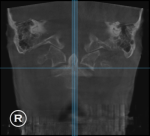The purpose of this case study is to demonstrate the application of Cone Beam CT (CBCT) scan as an effective imaging method for highly specific upper cervical chiropractic corrections.
Patient History
A 38 year old male presented to the clinic with a chief complaint of neck pain that has persisted for the past 7-8 years. The pain was progressing and becoming intrusive in his desired lifestyle. The patient stated that when the pain is at it’s worst, it radiates into bilateral shoulders and arms.
The precipitating cause is unknown. However the patient did have a MVA 4-5 years prior to the onset of symptoms and has actively participated in soccer for the past 30 years and recalls several times that the symptoms have increased following games where the head was used to deflect the ball.
The patient listed several associated complaints including lightheadedness and loss of equilibrium causing the patient to stop his routine and rest until the spell has past.
The patient also describes headache symptoms of both a tension headache and classic migraine precipitated by alcohol use. Pt states 2 episodes/week. Family history includes similar symptoms of migraine headaches. There is also mid back pain localized to the thoracic/lumbar region that is most notable in the evening.
Patient utilizes pain medication to manage the neck and headache symptoms, which helps but the problem persists.
Chiropractic Exam
Flexion of the neck causes increased pain refereed to the shoulders and arms. There was a negative sharp purser orthopedic test. Left C1 – C4 point tenderness and inflammation nodules were found at the posterior lateral vertebral joints.
The patient had muscle tightness on the left side of the neck as well as multiple muscle spams of the right upper Trapezius and Levator scapulae.
Posture analysis concluded an elevated left head by 2 cm, even shoulders and a high right hip by 1 cm.
Leg length inequality check revealed a 2 cm right short leg with a positive right c2 challenge.
Cervical temperature pattern was established using a Titron thermographic instrument.
Imaging Analysis
Imaging was ordered utilizing a seated 3D CBCT unit. On Demand 3D software was used for the analysis of the images following a variation of the Blair x-ray analysis.
The Foramen Magnum/Spinal Canal study found a large right rotation of axis. This was confirmed on the 3D view. The simulated protracto views found a double posterior misalignment of atlas. An exceptionally “tilted” atlas was found on the posterior 3D view that is also observed on the frontal generated x-ray view.
Care
Upper cervical chiropractic care following the Blair corrective protocol was elected to correct this upper cervical misalignment. Following the first correction and a 20 min rest period the thermographic scan demonstrated a change. The leg length inequality was found to be normal. The patient commented that he felt a bilateral burning sensation in the lower leg region, following the Achilles tendon.
A follow up visit two days later found the burning sensation in the lower legs continued. Cervical thermographic scan and leg length inequality tests were performed and found to negative. This means that the scan was remarkable different from the pattern that was established prior to care and the legs that were found to be uneven before care were found equal after the initial adjustment and continue to be equal 2 days later. The patient also noted a decrease in neck symptoms.
In all, 4 upper cervical corrections were given in a 3 month period and the patient continued to improve. The patient experiences fewer and less severe episodes of lightheadedness and reports that the tension headaches have become an infrequent occurrence.
(Editor's note: Remember the objective of upper cervical care is to correct head neck misalignment that is interfering with proper brain to body communication. When this is corrected the body functions at a higher level and can often correct other problems more efficiently on its own. Please do not confuse upper cervical care as a treatment for any condition, disease or symptom.)







